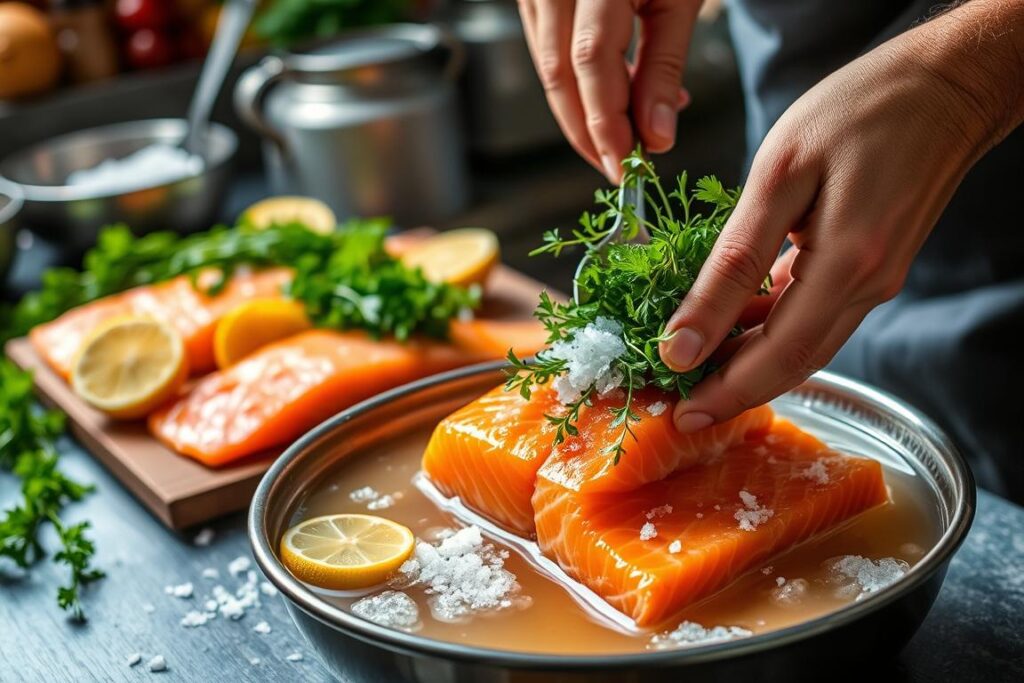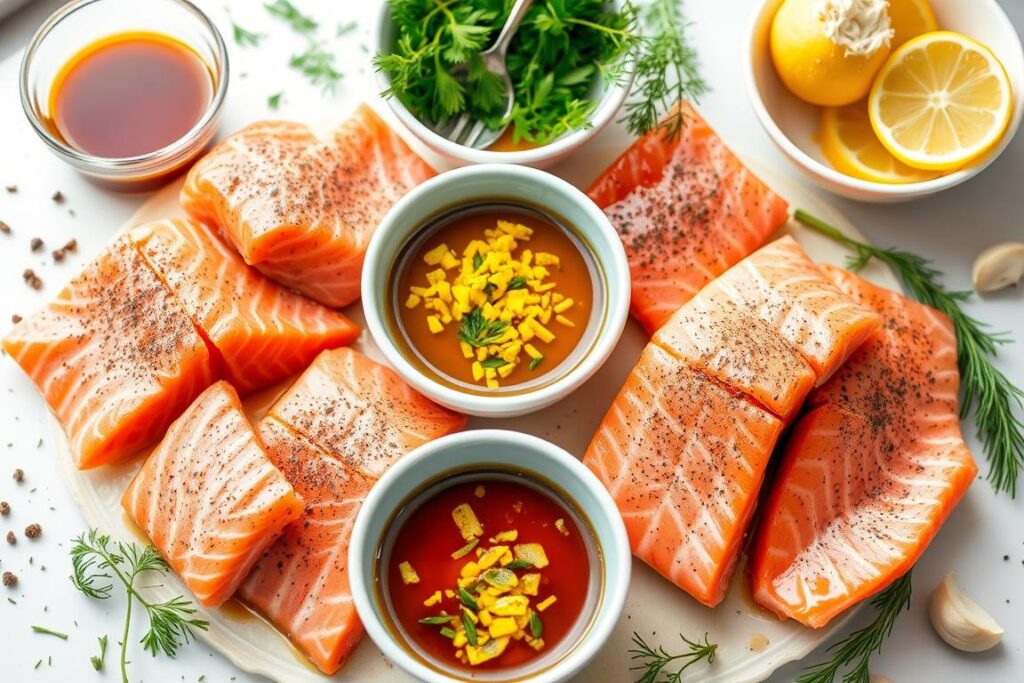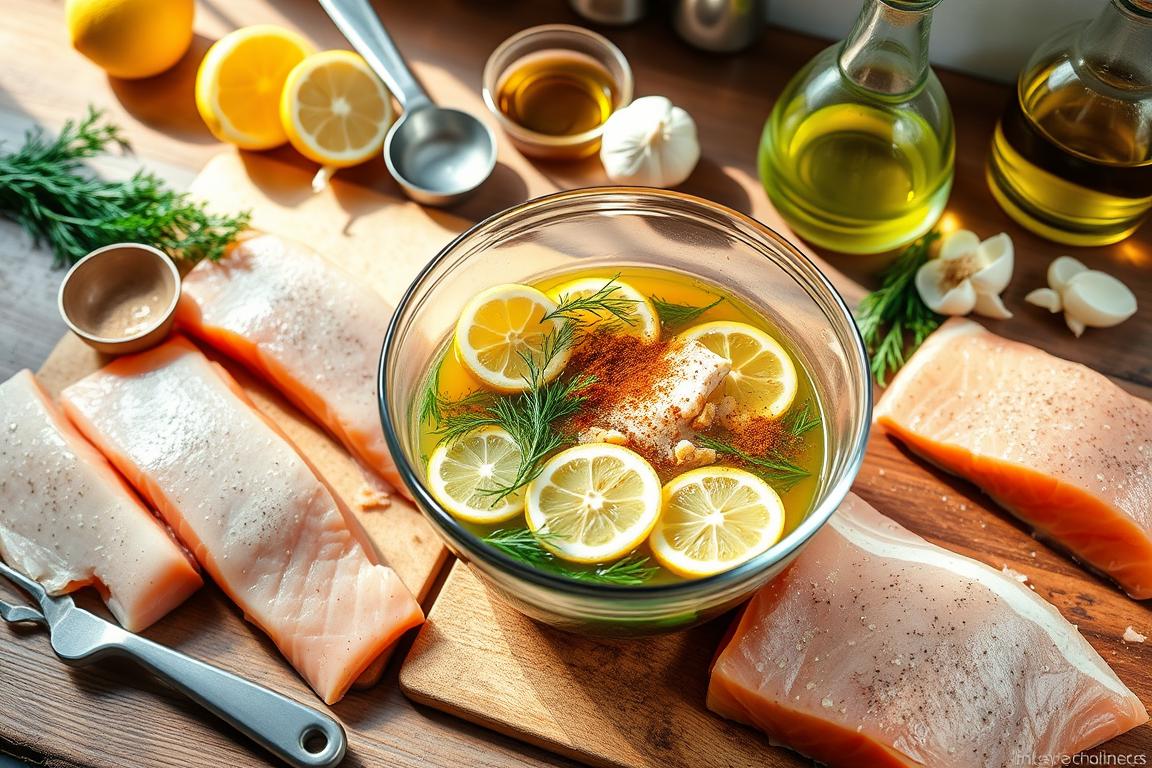Every home cook faces the challenge of serving fish that tastes too “fishy” or lacks the perfect texture. I’ve been there, wondering how chefs make salmon dishes that melt in your mouth. The secret is a pre-cooking treatment that turns ordinary fish into a culinary masterpiece.
Knowing the right soaking liquid can take your cooking from basic to brilliant. Whether you’re experienced or new, the right salmon seasoning can change your meal.
This guide will show you how to pre-cook salmon like a pro. You’ll learn insider techniques for making fish irresistible. From milk baths to citrus marinades, discover the secrets chefs use.
Ready to unlock the secrets of perfect salmon preparation? Your taste buds will thank you!
Understanding the Benefits of Pre-Cooking Salmon Soaks
Preparing salmon for cooking is more than just seasoning. Learning about pre-cooking soaks can change your seafood experience. With Americans eating about 2.4 pounds of salmon each year, knowing how to prepare it is key for home cooks and seafood lovers.

Why Soaking Makes a Difference
Soaking salmon in brine solution boosts flavor and texture. Salt water is key in curing salmon. It breaks down proteins and keeps moisture in. These steps can greatly improve how your fish tastes and feels when cooked.
- Reduces strong fishy odors
- Helps retain moisture during cooking
- Creates more tender fish texture
- Allows deeper flavor penetration
Essential Preparation Steps
Brining fish needs careful steps. Here are the main steps for preparing salmon:
- Remove pin bones carefully
- Rinse salmon under cold water
- Pat fish dry with paper towels
- Prepare appropriate brine solution
Impact on Flavor and Texture
Different soaking methods lead to different results. A brine solution can add subtle or bold flavors, depending on your ingredients and method.
| Soaking Method | Flavor Profile | Texture Result |
|---|---|---|
| Salt Water Brine | Mild, natural | Firm, smooth |
| Milk Soak | Delicate, mellow | Soft, tender |
| Citrus Marinade | Bright, zesty | Slightly firmer |
By learning these techniques, you’ll make your salmon preparation better. You’ll get delicious results every time you cook.
What Do You Soak Salmon In Before Cooking?

Preparing salmon needs careful thought about soaking methods. These methods can make your fish taste better and feel softer. You’ll find many liquid options to turn your salmon into a dish to remember.
There are different soaking techniques, each with its own benefits. Chefs suggest using certain liquids to improve your salmon’s taste and quality:
- Saltwater Brine: Keeps the fish moist
- Citrus Juices: Makes the flavor brighter and less fishy
- Milk Bath: Reduces strong smells
- White Wine: Adds a subtle complexity
The best soaking solution depends on what you want to achieve and your taste. Each method adds something unique to your salmon.
| Soaking Solution | Flavor Profile | Preparation Time |
|---|---|---|
| Saltwater Brine | Rich, Savory | 30-60 minutes |
| Lemon Juice | Bright, Zesty | 15-30 minutes |
| Milk | Mild, Smooth | 20-45 minutes |
| White Wine | Complex, Elegant | 30-60 minutes |
Timing is key when marinating salmon. A 6-ounce fillet needs 15-60 minutes, depending on the liquid. Always keep it in the fridge to stay safe.
Mastering the Milk and Citrus Soak Methods
Getting salmon ready for cooking is all about the right soaking techniques. Knowing what to soak salmon in can make a big difference in taste and texture.
The liquid you soak salmon in is key to reducing fishy smells and boosting flavor. There are various methods to get your seafood just right.
Proper Milk Soaking Techniques
Milk is great for getting rid of fishy odors. Here are some tips for using milk:
- Use whole milk for maximum effectiveness
- Soak salmon for 20-30 minutes
- Ensure the milk completely covers the fish
The milk’s casein protein works with trimethylamine to cut down on bad smells. Always rinse the salmon well after soaking to get rid of any milk taste.
Citrus Marinade Ratios and Timing
Citrus marinades are another top choice for salmon prep. Here’s how to do it right:
- Mix equal parts citrus juice and water
- Soak salmon for 15 minutes maximum
- Use fresh lemon or lime juice for best results
The acidity in citrus helps break down proteins, making the fish tender and tasty.
Combining Different Soaking Methods
Many chefs mix soaking methods for better flavor and texture. A common mix is:
- Brief citrus soak (10 minutes)
- Followed by a milk bath (15-20 minutes)
- Pat dry before cooking
This way, your salmon won’t have strong smells but will taste great and be tender.
Essential Timing and Temperature Guidelines
When cooking salmon, knowing the right timing and temperature is key. Pre-cooking salmon needs careful soaking and cooking. This ensures the best flavor and safety.
Here are some important guidelines for cooking salmon:
- FDA recommends an internal temperature of 145°F.
- Chefs prefer a temperature of 125°F for moist salmon.
- Grill at 350°F-400°F for the best results.
- Grill for about 15 minutes total.
Soaking times are also important for salmon preparation. Here’s a quick guide:
| Soaking Method | Recommended Time |
|---|---|
| Citrus or Vinegar Soak | 10-15 minutes |
| Saltwater Brine | Up to 30 minutes |
| Overnight Marinade | Less acidic mixtures recommended |
Remember these important tips when cooking salmon:
- Keep salmon refrigerated during soaking for safety.
- Don’t soak for over an hour to avoid texture loss.
- Use a meat thermometer to check the internal temperature.
Pro tip: Brined salmon cooks faster and stays moister than un-brined filets.
Conclusion
Learning how to soak salmon before cooking can make a big difference. The right seasoning techniques add a rich flavor that’s a joy to taste. You’ve seen how different soaking methods can enhance this tasty fish.
Trying out different soaking techniques gives you many ways to prepare salmon. You can use milk to reduce fishiness, citrus for a bright taste, or saltwater for a classic flavor. Knowing these methods lets you tailor your salmon to your liking.
Timing is key when cooking salmon. Most marinades work best for 30 minutes or less. This keeps the fish from getting too acidic or losing its tender texture. By focusing on these details, you’ll make your salmon a standout dish that wows everyone.
Using these soaking and seasoning tips will show off your cooking skills. With a bit of practice, you’ll find the best way to make salmon a memorable meal. It proves that a little effort can greatly improve your cooking.
FAQ
What are the best liquids to soak salmon in before cooking?
The top liquids for soaking salmon include saltwater brines, citrus juices, whole milk, white wine, and herb baths. Saltwater brines keep the fish moist. Citrus juices cut down on fishy smells. Milk soaks can soften strong tastes. Herb baths add a nice flavor.
How long should I soak salmon before cooking?
Soaking times differ by liquid. Citrus or vinegar soaks last 10-15 minutes. Saltwater brines or herb baths can soak for up to 30 minutes. Don’t soak for more than an hour to keep the fish firm.
For milk soaks, 20 minutes is best to reduce fishy smells.
Can soaking salmon improve its flavor and texture?
Yes, soaking can make salmon taste and feel better. Saltwater brines keep it moist and firm. Citrus adds a bright taste. Milk soaks can make it less fishy.
The right soak can turn regular salmon into a tasty dish.
What is the best way to soak salmon in milk?
Soak salmon in whole milk for about 20 minutes in the fridge. This method softens the fishy smell and taste. After soaking, dry the salmon well before cooking.
Are there any risks to soaking salmon for too long?
Yes, soaking too long can make salmon tough or mushy. Acidic marinades or brines can harm the texture. Stick to soaking times of 30 minutes or less and keep it cold.
Can I combine different soaking methods?
Absolutely! Mixing methods can improve the salmon’s taste. Try a citrus soak followed by a milk bath. Just watch the total time and avoid over-soaking.
What internal temperature should salmon be cooked to?
Cook salmon to 145°F for safety, says the FDA. But chefs often cook to 125°F for juicier fish. Grill at medium heat, about 350°F to 400°F, for 5 minutes per side.

